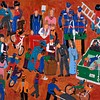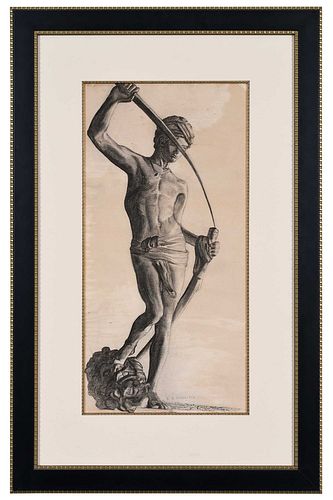Edwin Augustus Harleston
Bid Increments
| Price | Bid Increment |
|---|---|
| $0 | $25 |
| $100 | $50 |
| $1,000 | $100 |
| $2,000 | $200 |
| $3,000 | $250 |
| $5,000 | $500 |
| $10,000 | $1,000 |
| $20,000 | $2,000 |
| $50,000 | $5,000 |
| $100,000 | $10,000 |
(American/South Carolina, 1882-1931)
Sketch of David after Antonin Mercie sculpture, signed lower edge "E A Harleston", charcoal on paper, site 24 x 12 in.; modern frame, 35-1/2 x 22-3/4 in.
See lot 505 for the bronze by Antonin Mercié.
Literature: “Edwin Harleston ”: The Johnson Collection, LLC, thejohnsoncollection.org/edwin-harleston/. Accessed 12 Apr. 2023.
Constantly constrained by both racial barriers and family duty, Edwin Augustus Harleston, who was once described by W. E. B. Du Bois as the “leading portrait painter of the race,” was never able to fully devote himself to his art. Born in Charleston, South Carolina to a prosperous African American family, “Teddy” Harleston graduated as valedictorian from the Avery Normal Institute, the first accredited secondary school for African Americans in the area. He went on to attend Atlanta University, where he studied under Du Bois, a renowned scholar and future co-founder of the NAACP. His enduring relationship with Du Bois fueled Harleston’s academic ambitions and political activism. Determined to rise to his mentor’s challenge to the “talented tenth,” Harleston “took seriously his moral obligation to serve as a guide for [his] race” and would later serve as the first president of the Charleston chapter of the NAACP in 1917. Following his college graduation, Harleston enrolled at the prestigious School of the Museum of Fine Arts in Boston, foregoing his admission to Harvard. Over his six-year tenure in Boston, his instructors included Frank Benson and Edmund Tarbell; in 1924 and 1925, Harleston was a summer student at the Art Institute of Chicago.
Despite his promising start as a professional artist in Boston, Harleston was pressured by his father to return to Charleston in 1912 and assume responsibilities with the family funeral home. The tension between family obligations and artistic passion pervaded Harleston’s adult life. In 1920, he married Elise Forrest, who became a respected photographer. Two years later, the couple opened a photography studio—which included space for Edwin to paint—across the street from the Harleston Funeral Home. A first for the African American citizens of Charleston, the establishment sought “to furnish the people of this community who are interested in works of art with portraits, in the following media, oil painting, charcoal, pastel, and French crayons.” In the years that followed, Harleston met with modest success as a painter; racial prejudices and segregation prevented several high profile commissions from coming to fruition and derailed a planned 1926 exhibition of his work at the Charleston Museum. In response, Harleston turned his attention to painting working African Americans. In a 1923 letter to Elise, he explained his plan to carry on the legacy of Henry Ossawa Tanner by portraying African Americans “in our varied lives and types with the classic technique and the truth, not caricatures . . . to do the dignified portrait and take the picturesque composition of arrangements or scenes showing the thousand and one interests of our group in industry, religion, general social contact.”
Harleston often used photographs taken by Elise as source material for his portraits. One example of this practice is Miss Bailey with the African Shawl, widely regarded as one of the artist’s finest works. Sue Bailey, a New Yorker with extensive connections in Harlem’s cultural community, was the national traveling secretary for the YWCA and, in that role, visited Charleston to establish a high school chapter for African-American girls. The three-quarter seated pose executed in strong color, reflects the artist’s sure academic foundation and mastery of mood. Harleston was quite proud of the portrait and entered it in the 1931 Harmon Foundation juried exhibition.
In addition to portrait commissions, Harleston also created paintings depicting many of the local figures—such as black street vendors—featured in works by other artists of the Charleston Renaissance era. In 1930, Aaron Douglas, one of the leading figures of the Harlem Renaissance, invited Harleston to assist him in completing a mural commission at Fisk University in Nashville. Harleston readily accepted the younger painter’s offer and spent several months working on the project alongside him. The unfinished murals form a backdrop to Harleston’s 1930 portrait of Douglas, a departure from more typical neutral backgrounds seen in other portraits, like that of Miss Bailey.
Edwin Harleston died from pneumonia at the age of forty-nine in Charleston. Today, his works are represented in the collections of the Gibbes Museum of Art, Savannah College of Art and Design Museum of Art, and the California African American Museum.
Condition
paper slightly toned, small spots of foxing, wavy at left edge, not examined out of frame; frame with light wear
Purchased items will be available for pick up or shipping from our Asheville, North Carolina auction facility within ten business days of the auction will be assessed a storage fee of $5.00 per day, per item. Purchaser agrees that packing and shipping is done at the purchaser's risk and that the purchaser will pay in advance all packing expenses, materials, carrier fees and insurance charges. At our discretion, items will either be packed by an agent such as a packaging store or Brunk Auctions. Please allow two weeks for shipping after payment is received. Shipment of large items is the responsibility of the purchaser. We are happy to provide names of carriers and shippers if a purchaser so requests. Brunk Auctions will have no liability for any loss or damage to shipped items.
Private Collection, Washington, D. C.









